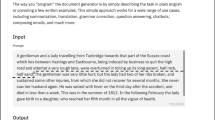Abstract
Automatically generated papers have been used to manipulate bibliography indexes on numerous occasions. This paper is interested in different means to generate texts such as recurrent neural network, Markov model, or probabilistic context free grammar, and if it is possible to detect them using a current approach. Then, probabilistic context free grammar (PCFG) is focused on as the one most used. However, even though there have been multiple approaches to detect such types of paper, they are all working at the document level and are unable to detect a small amount of generated text inside a larger body of genuinely written text. Thus, we present the grammatical structure similarity measurement to detect sentences or short fragments of automatically generated text from known PCFG generators. The proposed approach is tested against a pattern checker and various common machine learning methods. Additionally, the ability to detect a modified PCFG generator is also tested.






Similar content being viewed by others
Notes
Intel Core I5 2.4 GHz with 16Gb Ram.
References
Amancio, D. R. (2015). Authorship recognition via fluctuation analysis of network topology and word intermittency. Journal of Statistical Mechanics: Theory and Experiment, 2015(3), P03005.
Amancio, D. R., Oliveira, O. N, Jr., & Costa, L. D. F. (2012). Structuresemantics interplay in complex networks and its effects on the predictability of similarity in texts. Physica A: Statistical Mechanics and its Applications, 391(18), 4406–4419.
Amancio, D. R. (2015). Comparing the topological properties of real and artificially generated scientific manuscripts. Scientometrics, 105(3), 1763–1779.
Amancio, D. R. (2015). A complex network approach to stylometry. PLOS One, 10(8), e0136076.
Amancio, D. R., Comin, C. H., Casanova, D., Travieso, G., Bruno, O. M., Rodrigues, F. A., et al. (2014). A systematic comparison of supervised classifiers. PLOS One, 9(4), 1–14.
Bohannon, J. (2013). Who’s afraid of peer review? Science, 342(6154), 60–65.http://science.sciencemag.org/content/342/6154/60
Chomsky, N. (1956). Three models for the description of language. IEEE Transactions on Information Theory, 2(2), 113–124.
Collingwood, L., Jurka, T., Boydstun, A., Grossman, E., & van Atteveldt, W. (2013). Rtexttools: A supervised learning package for text classification. The R Journal, 5(1), 6–13.
Culotta, A., & Sorensen, J. (2004). Dependency tree kernels for relation extraction. In Proceedings of the 42nd annual meeting on association for computational linguistics, ACL ’04, Association for Computational Linguistics, Stroudsburg, PA, USA.
Durán, K., Rodríguez, J., & Bravo, M. (2014). Similarity of sentences through comparison of syntactic trees with pairs of similar words. In 2014 11th international conference on electrical engineering, computing science and automatic control (CCE) (pp. 1–6).
Ginsparg, P. (2014). Automated screening: ArXiv screens spot fake papers. Nature, 508(7494), 44.
Graves, A. (2013). Generating sequences with recurrent neural networks. CoRR arXiv:abs/1308.0850
Kao, J. (2017). More than a million pro-repeal net neutrality comments were likely faked. https://hackernoon.com/more-than-a-million-pro-repeal-net-neutrality-comments-were-likely-faked-e9f0e3ed36a6. Accessed November 2017.
Klein, D., & Manning, C. D. (2003). Fast exact inference with a factored model for natural language parsing. In Advances in neural information processing systems 15 (NIPS) (pp. 3–10). MIT Press
Labbe, C. (2010). Ike Antkare one of the great stars in the scientific firmament. ISSI Newsletter, 6(2), 48–52.
Labbé, C., & Labbé, D. (2013). Duplicate and fake publications in the scientific literature: How many scigen papers in computer science? Scientometrics, 94(1), 379–396.
Labbé, C., Labbé, D., & Portet, F. (2016). Detection of computer-generated papers in scientific literature (pp. 123–141). Berlin: Springer.
Lavoie, A., & Krishnamoorthy, M. (2010). Algorithmic detection of computer generated text. arXiv preprint arXiv:1008.0706.
López-Cózar, E. D., Robinson-Garcia, N., & Torres-Salinas, D. (2012). Manipulating google scholar citations and google scholar metrics: Simple, easy and tempting. CoRR arXiv:abs/1212.0638
Nguyen, M., & Labbé, C. (2016). Engineering a tool to detect automatically generated papers. In Proceedings of the third workshop on bibliometric-enhanced information retrieval co-located with the 38th European conference on information retrieval (ECIR 2016) (pp. 54–62).
Noorden, R. V. (2014). Publishers withdraw more than 120 gibberish papers. Nature News.
Ortuno, M., Carpena, P., Bernaola-Galván, P., Munoz, E., & Somoza, A. M. (2002). Keyword detection in natural languages and DNA. EPL (Europhysics Letters), 57(5), 759.
Sochenkov, I., Zubarev, D., Tikhomirov, I., Smirnov, I., Shelmanov, A., Suvorov, R., & Osipov, G. (2016). Exactus like: Plagiarism detection in scientific texts. In: European conference on information retrieval (pp. 837–840).
Sutskever, I., Martens, J., & Hinton, G.E. (2011). Generating text with recurrent neural networks. In Proceedings of the 28th international conference on machine learning (ICML-11). pp. 1017–1024.
Wang, R., & Neumann, G. (2007). Recognizing textual entailment using sentence similarity based on dependency tree skeletons. In: Proceedings of the ACL-PASCAL workshop on textual entailment and paraphrasing, RTE ’07 (pp. 36–41). Association for Computational Linguistics, Stroudsburg, PA, USA.
Williams, K., & Giles, C. L. (2015). On the use of similarity search to detect fake scientific papers. In 8th international conference similarity search and applications, SISAP 2015 (pp. 332–338).
Xiong, J., & Huang, T. (2009). An effective method to identify machine automatically generated paper. In Knowledge engineering and software engineering (pp. 101–102).
Zubarev, D., & Sochenkov, I. (2014). Using sentence similarity measure for plagiarism source retrieval. In CLEF (Working Notes) (pp. 1027–1034).
Author information
Authors and Affiliations
Corresponding author
Rights and permissions
About this article
Cite this article
Tien, N.M., Labbé, C. Detecting automatically generated sentences with grammatical structure similarity. Scientometrics 116, 1247–1271 (2018). https://doi.org/10.1007/s11192-018-2789-4
Received:
Published:
Issue Date:
DOI: https://doi.org/10.1007/s11192-018-2789-4






